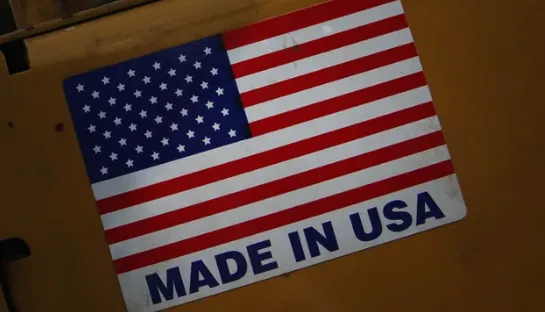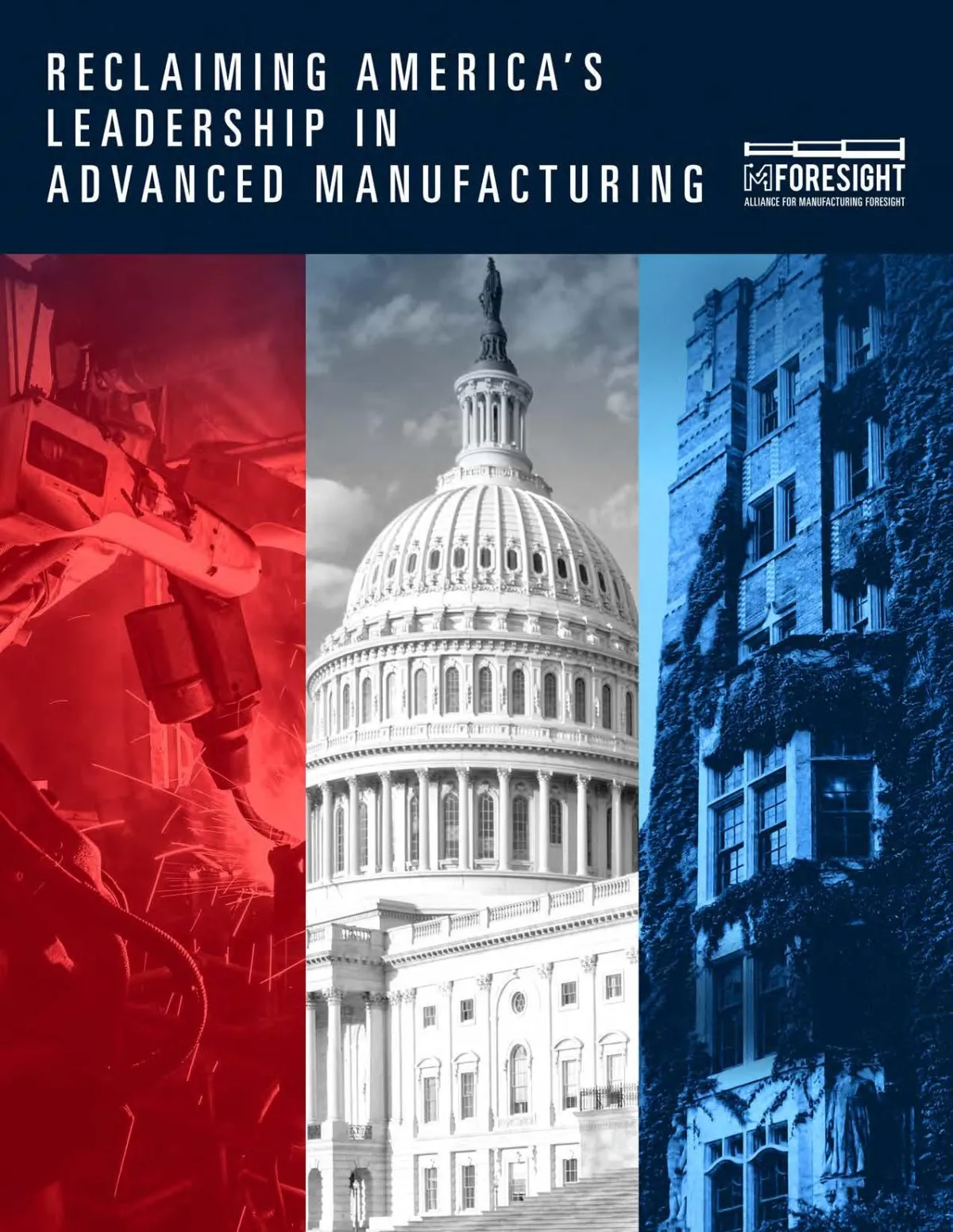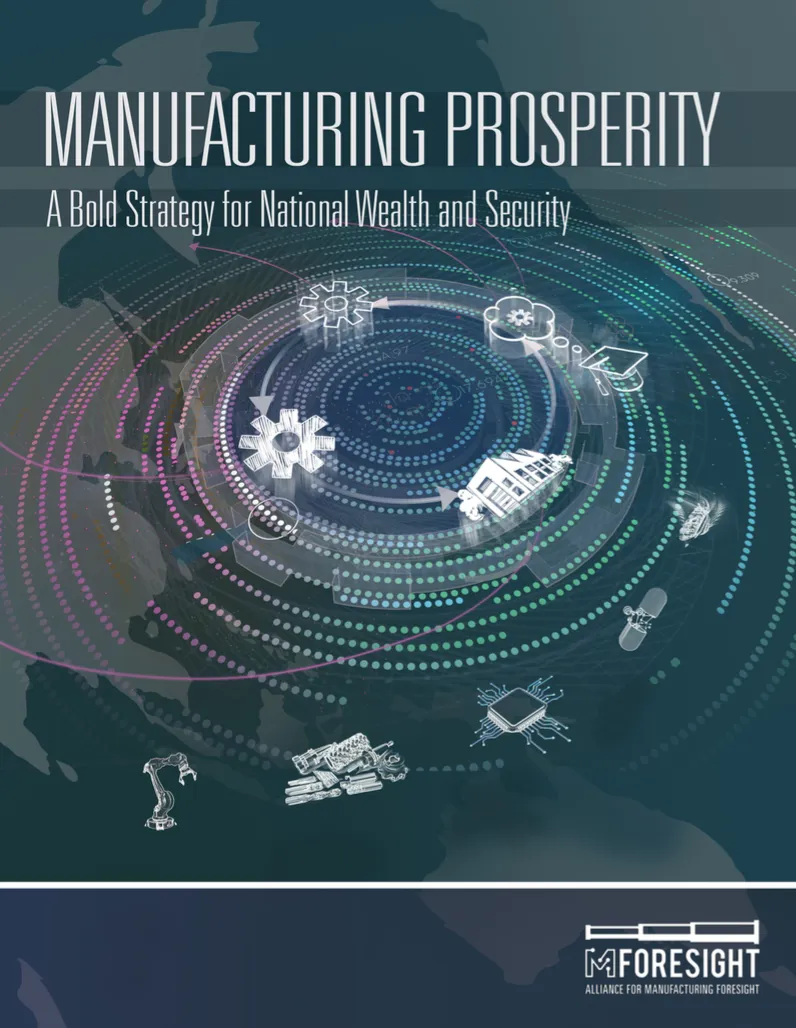ALLIANCE FOR
MANUFACTURING FORESIGHT
Engaging the U.S. manufacturing community to discover, prioritize, develop, and disseminate emerging technologies and manufacturing needs aligned with national priorities

About us
MForesight: Alliance for Manufacturing Foresight
was established in 2015 at the University of Michigan to advise the federal government and the nation’s manufacturing community on emerging technologies, skill requirements, trade, and other factors affecting long-term U.S. manufacturing competitiveness. After funding lapsed in 2020, MForesight was no longer able to provide the timely analysis, technology assessments, and actionable policy recommendations found in multiple reports. Because much of this information continues to be relevant, this website serves as a repository for MForesight’s publications, available for free download.
Our focus includes:
Research and Development Priorities
Implementation Challenges
Technology Policy Issues
Featured Articles
Explore Our Archive of Manufacturing Foresight

Invent here, manufacture here | The Hill
Invent here, manufacture here
Much has been written about erosion of the U.S. industrial base, the loss of engineering skills, and the lack of manufacturing know-how as more and more production moved to Asia. The direct results include long supply chains, empty shelves and sky-high shipping costs in almost any industry you care to name, imposing real hardships on Americans. It’s easy to blame corporate America for putting profits ahead of national interests, and it’s easy to proclaim this time will be different. But the reality is that business knows this crisis will pass and the cost advantages of offshore production will be as strong as ever, short-term profits taking priority over national interests. Effective national policy could change this calculus. For 40 years, industrial policy has been the “third rail” of American politics. Washington has been united in a bipartisan consensus that free trade and free markets best determine economic progress, fervently avoiding any explicit national planning to promote (or even identify) U.S. economic priorities.
But with greater speed and scale than anyone could have predicted that consensus is crumbling. Sen. Marco Rubio (R-Fla.) has called for national economic goals pursued with the full force of the state to counter a rising China, and Sen. Elizabeth Warren (D-Mass.) has called for a new “economic patriotism”. The Senate passed the United States Innovation (USICA) that will go to conference with the House’s America Competes Act. The Infrastructure Investment and Job Act, signed into law by President Biden in November, also has a number of provisions that could boost domestic manufacturing if the government refrains from rushing to cheap imports.
These legislative efforts should be good news for revitalizing American manufacturing, but any positive impact will depend on effective implementation. We cannot simply throw more money at old programs that have failed to maintain, let alone grow, the nation’s industrial base.
One important area that has received insufficient attention is any new thinking on federally funded research and development (R&D). The federal government currently spends over $160 billion annually on R&D — and more than $3 trillion since 2000 — but with little strategic intent. Most federal R&D spending is based on momentum: federal departments get increases (or cuts) to R&D budgets based on last year’s budget with little analysis of what that money buys. Congress doesn’t require any calculation of any real return on investment and hasn’t required any metrics to measure returns, be they scientific, social, economic, or strategic. (To be fair, Congress calls it spending, not investment.) Patents and licenses resulting from R&D spending are necessary first steps to generate returns, but they are poor proxies at best for impact because by themselves they do not create national wealth, jobs or national security. We need to manufacture our inventions at scale just like other countries have scaled our inventions — cell phones, flat-panel displays, solar cells, and lithium-ion batteries, for example — to create tens of millions of jobs.
Put simply, we need to make what we invent. Scientific discoveries and inventions may produce bragging rights — the most patents, the most citations or Nobel prizes — but invention is not the same as innovation. Innovation requires transforming promising inventions into products manufactured at scale. By that definition we have not done much innovation in hardware, in a generation. Without innovation, we do not create much national wealth from the billions spent on taxpayer-funded R&D.
Just as tax cuts for the rich do not trickle down to help the masses, spending on science alone and relying on the magic hand of the free market to do the rest, has not trickled down to create private-sector jobs or to improve national security. We badly need a national manufacturing strategy that includes a strategic assessment of R&D priorities and effective policies as well as programs to ensure a pathway for promising R&D results to be manufactured here. The Bayh-Dole Act of 1980 provides the legal basis for recipients of federal research funding to license and receive income from resulting patents. It requires that licensed inventions be substantially manufactured in the United States unless a waiver is granted by the funding agency. In practice, waivers are easy to get and are rarely denied. Tweaking this act may give some satisfaction, but it will not change the trajectory. Congress should require that, for any product or process derived from federally funded R&D, at least 75 percent of the value added must be produced in the United States.
This is the same standard established for automobile production in the United States-Mexico-Canada Agreement. The only exception to this requirement would be a temporary waiver for up to one year due to a demonstrated on-going national emergency. Such a waiver, an Emergency Manufacturing Authorization (EMA), will be issued by the White House or Congress during an emergency (like the Emergency Use Authorizations issued by the FDA during the COVID-19 pandemic). This is the only way to ensure a real return on investment back to American taxpayers who funded that research in the first place. If, for whatever reason, the ability to manufacture in the U.S. is lacking, at least those gaps would be identified, and steps could be taken to address them. These could include programs such as loans and grants for startups to build and test prototypes, early government procurement to accelerate pilot production, and public-private financial assistance to scale manufacturing. Despite likely complaints from researchers and their institutions, this policy will not affect the efficacy of our R&D enterprise; it only affects the outcomes — strengthening the industrial commons, jobs, and national security. Bear in mind that no one is obligated or entitled to take taxpayer dollars for R&D. Furthermore, any R&D funded privately can still be manufactured anywhere in the world.
Before we spend taxpayer dollars importing high-value products or components to build our physical infrastructure or fund new and existing programs under USICA, Congress and the administration should institute legislation with a meaningful “invent here, manufacture here” policy. That would be the first step toward rebuilding our manufacturing-innovation ecosystem to rekindle American ingenuity, to create jobs, and to strengthen military preparedness. Otherwise, we will continue to watch other countries pick our winners while subsidizing wealth creation in other countries with American taxpayer dollars.
Sridhar Kota is Herrick professor emeritus of engineering at the University of Michigan and a manufacturing entrepreneur for over 30 years. He is the former assistant director for advanced manufacturing (2009 to 2012) at the White House Office of Science and Technology. He is the founding executive director of MForesight: Alliance for Manufacturing Foresight, a national think-and-do tank focused on accelerating technological innovation to enhance U.S. manufacturing competitiveness. He is the founder and CEO of FlexSys Inc. and Inspire Rx LLC. Thomas Mahoney is associate director of MForesight. He has over 30 years of experience addressing manufacturing competitiveness issues in the U.S. and New Zealand and working directly with manufacturers to improve factory operations. He has been executive director of the National Academies' Manufacturing Studies Board, president of WVMEP, CEO of technology startup Plasma Igniter, and chief economist for New Zealand's Ministry of Research, Science and Technology.
Manufacturing Community News
Community Events and Initiatives

Invent here, manufacture here | The Hill
Invent here, manufacture here
Much has been written about erosion of the U.S. industrial base, the loss of engineering skills, and the lack of manufacturing know-how as more and more production moved to Asia. The direct results include long supply chains, empty shelves and sky-high shipping costs in almost any industry you care to name, imposing real hardships on Americans. It’s easy to blame corporate America for putting profits ahead of national interests, and it’s easy to proclaim this time will be different. But the reality is that business knows this crisis will pass and the cost advantages of offshore production will be as strong as ever, short-term profits taking priority over national interests. Effective national policy could change this calculus. For 40 years, industrial policy has been the “third rail” of American politics. Washington has been united in a bipartisan consensus that free trade and free markets best determine economic progress, fervently avoiding any explicit national planning to promote (or even identify) U.S. economic priorities.
But with greater speed and scale than anyone could have predicted that consensus is crumbling. Sen. Marco Rubio (R-Fla.) has called for national economic goals pursued with the full force of the state to counter a rising China, and Sen. Elizabeth Warren (D-Mass.) has called for a new “economic patriotism”. The Senate passed the United States Innovation (USICA) that will go to conference with the House’s America Competes Act. The Infrastructure Investment and Job Act, signed into law by President Biden in November, also has a number of provisions that could boost domestic manufacturing if the government refrains from rushing to cheap imports.
These legislative efforts should be good news for revitalizing American manufacturing, but any positive impact will depend on effective implementation. We cannot simply throw more money at old programs that have failed to maintain, let alone grow, the nation’s industrial base.
One important area that has received insufficient attention is any new thinking on federally funded research and development (R&D). The federal government currently spends over $160 billion annually on R&D — and more than $3 trillion since 2000 — but with little strategic intent. Most federal R&D spending is based on momentum: federal departments get increases (or cuts) to R&D budgets based on last year’s budget with little analysis of what that money buys. Congress doesn’t require any calculation of any real return on investment and hasn’t required any metrics to measure returns, be they scientific, social, economic, or strategic. (To be fair, Congress calls it spending, not investment.) Patents and licenses resulting from R&D spending are necessary first steps to generate returns, but they are poor proxies at best for impact because by themselves they do not create national wealth, jobs or national security. We need to manufacture our inventions at scale just like other countries have scaled our inventions — cell phones, flat-panel displays, solar cells, and lithium-ion batteries, for example — to create tens of millions of jobs.
Put simply, we need to make what we invent. Scientific discoveries and inventions may produce bragging rights — the most patents, the most citations or Nobel prizes — but invention is not the same as innovation. Innovation requires transforming promising inventions into products manufactured at scale. By that definition we have not done much innovation in hardware, in a generation. Without innovation, we do not create much national wealth from the billions spent on taxpayer-funded R&D.
Just as tax cuts for the rich do not trickle down to help the masses, spending on science alone and relying on the magic hand of the free market to do the rest, has not trickled down to create private-sector jobs or to improve national security. We badly need a national manufacturing strategy that includes a strategic assessment of R&D priorities and effective policies as well as programs to ensure a pathway for promising R&D results to be manufactured here. The Bayh-Dole Act of 1980 provides the legal basis for recipients of federal research funding to license and receive income from resulting patents. It requires that licensed inventions be substantially manufactured in the United States unless a waiver is granted by the funding agency. In practice, waivers are easy to get and are rarely denied. Tweaking this act may give some satisfaction, but it will not change the trajectory. Congress should require that, for any product or process derived from federally funded R&D, at least 75 percent of the value added must be produced in the United States.
This is the same standard established for automobile production in the United States-Mexico-Canada Agreement. The only exception to this requirement would be a temporary waiver for up to one year due to a demonstrated on-going national emergency. Such a waiver, an Emergency Manufacturing Authorization (EMA), will be issued by the White House or Congress during an emergency (like the Emergency Use Authorizations issued by the FDA during the COVID-19 pandemic). This is the only way to ensure a real return on investment back to American taxpayers who funded that research in the first place. If, for whatever reason, the ability to manufacture in the U.S. is lacking, at least those gaps would be identified, and steps could be taken to address them. These could include programs such as loans and grants for startups to build and test prototypes, early government procurement to accelerate pilot production, and public-private financial assistance to scale manufacturing. Despite likely complaints from researchers and their institutions, this policy will not affect the efficacy of our R&D enterprise; it only affects the outcomes — strengthening the industrial commons, jobs, and national security. Bear in mind that no one is obligated or entitled to take taxpayer dollars for R&D. Furthermore, any R&D funded privately can still be manufactured anywhere in the world.
Before we spend taxpayer dollars importing high-value products or components to build our physical infrastructure or fund new and existing programs under USICA, Congress and the administration should institute legislation with a meaningful “invent here, manufacture here” policy. That would be the first step toward rebuilding our manufacturing-innovation ecosystem to rekindle American ingenuity, to create jobs, and to strengthen military preparedness. Otherwise, we will continue to watch other countries pick our winners while subsidizing wealth creation in other countries with American taxpayer dollars.
Sridhar Kota is Herrick professor emeritus of engineering at the University of Michigan and a manufacturing entrepreneur for over 30 years. He is the former assistant director for advanced manufacturing (2009 to 2012) at the White House Office of Science and Technology. He is the founding executive director of MForesight: Alliance for Manufacturing Foresight, a national think-and-do tank focused on accelerating technological innovation to enhance U.S. manufacturing competitiveness. He is the founder and CEO of FlexSys Inc. and Inspire Rx LLC. Thomas Mahoney is associate director of MForesight. He has over 30 years of experience addressing manufacturing competitiveness issues in the U.S. and New Zealand and working directly with manufacturers to improve factory operations. He has been executive director of the National Academies' Manufacturing Studies Board, president of WVMEP, CEO of technology startup Plasma Igniter, and chief economist for New Zealand's Ministry of Research, Science and Technology.
MForesight’s work was supported by the National Science Foundation from 2015 to 2020 under Grant No. 1552534 to the University of Michigan (Dr. Sridhar Kota).
Please note that any opinions, findings, and conclusions or recommendations expressed on this website do not necessarily reflect the views of the National Science Foundation or the University of Michigan.





